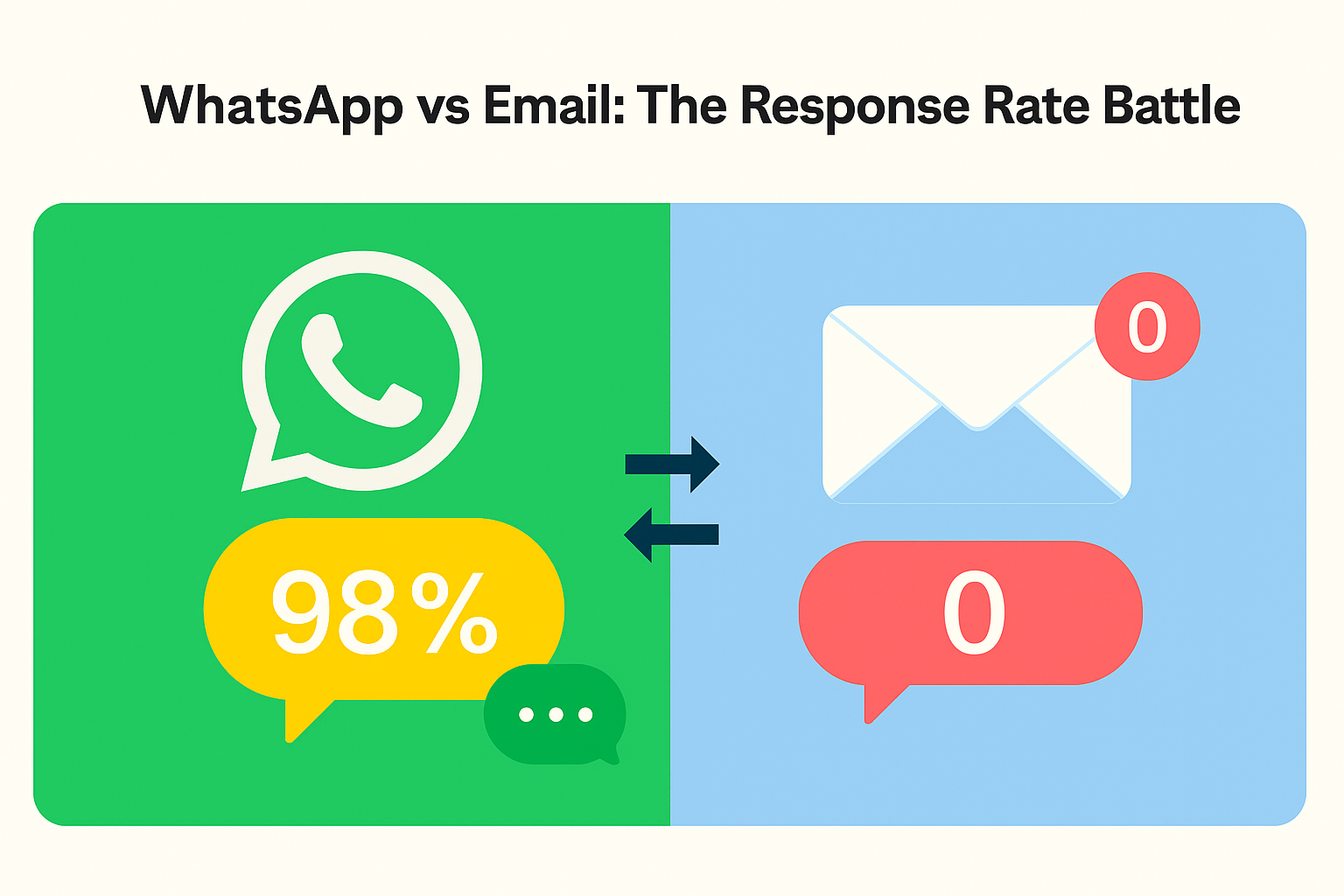For decades, email has been the backbone of business communication. But things have changed. People are overwhelmed, inboxes are flooded, and even the best-crafted emails are ignored or delayed. Meanwhile, one platform consistently delivers response rates email marketers can only dream of:
In this post, we break down the WhatsApp vs Email battle—and explain why more UK SMEs are ditching inboxes for instant messaging.
1. 📬 The Open Rate Problem
Let’s start with the numbers:
| Channel | Average Open Rate | Average Response Time |
|---|---|---|
| 18% | 90 minutes+ | |
| 98% | 2 minutes |
The difference is staggering.
Why? Because WhatsApp is personal, native to mobile, and signals urgency. Emails sit in cluttered inboxes with spam filters, folders, and distractions. WhatsApp? It pops right in front of you—no fancy formatting needed.
2. 💬 Why WhatsApp Feels More Human
Messaging apps mimic the way we naturally communicate: quick, informal, responsive.
When you send a WhatsApp message to a customer, it lands like a message from a friend—not a faceless company. That alone boosts engagement.
Even when automated via chatbot, WhatsApp still feels personal. You can:
- Ask short, clear questions
- Use emojis or voice notes
- Provide real-time updates
- Send clickable menu options
And the best part? You can automate it all.
With the right chatbot (like the ones we build at Gabba), customers get instant answers—24/7—without ever knowing there’s no human behind the screen (unless you want there to be).
3. ✉️ Why Email Is Struggling (Especially for SMEs)
Email still has its place—for longform content, legal documents, or newsletters. But for sales, support, and lead generation, it’s rapidly losing ground.
Here’s where email breaks down:
- ❌ Low open rates
- ❌ Spam/junk filtering
- ❌ No urgency or interactivity
- ❌ Difficult to automate two-way conversations
- ❌ Often requires desktop access
For time-poor businesses, chasing responses via email is like shouting into a void.
4. ⚔️ Real Use Cases: WhatsApp in Action
✅ Recruitment
A recruitment agency switched from email to WhatsApp for candidate comms. Pre-screen questions that went ignored over email were answered in under 10 minutes on WhatsApp. Time-to-fill dropped by 30%.
✅ Customer Service
A health clinic used WhatsApp to confirm and reschedule appointments. No-shows dropped by 40%. The chatbot handled 80% of queries without human involvement.
✅ Sales Follow-up
An automotive company added a WhatsApp chatbot after Facebook ad clicks. Response time fell from hours to seconds—and lead conversion improved by 65%.
All of these were done without developers using Gabba’s plug-and-play chatbot setup.
5. 🤖 But Can’t I Just Use Both?
Yes—smart businesses do.
Here’s how:
- Use WhatsApp for high-priority, real-time comms (support, sales, scheduling).
- Use email for backup, documents, and ongoing nurture (newsletters, quotes).
At Gabba, we often design automation flows that trigger based on platform:
- A lead submits an enquiry → Instant WhatsApp message + fallback email
- No reply after 10 minutes → WhatsApp reminder
- Still no reply after 24 hours → Final email
Smart routing = higher conversions, faster resolutions.
6. 🛠️ How to Start Using WhatsApp for Business
You don’t need a dev team or big budget.
At We Are Gabba, we build WhatsApp chatbots that plug into your CRM, website, and support channels. You’ll get:
- Message templates that convert
- Automated menus and Q&As
- CRM sync for instant updates
- Real-time analytics to track replies
And it works on your current phone number—no new hardware required.
TL;DR: WhatsApp Wins the Response Battle
📉 Email is slow, ignored, and getting worse.
📈 WhatsApp is fast, engaging, and easy to automate.
If your business depends on timely replies—WhatsApp should be your frontline.
💡 Want to See WhatsApp Automation in Action?
We’ll show you a live demo of what’s possible—no jargon, no pressure.
👉 Book a 15-Minute Chat
🔗 Or explore our WhatsApp Chatbot Services for use cases, pricing, and setup options.


